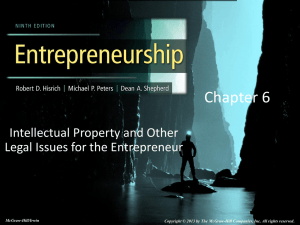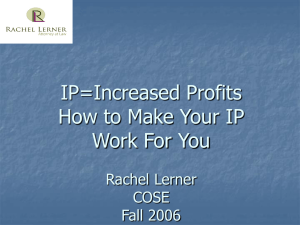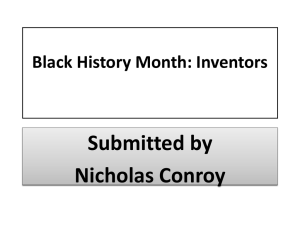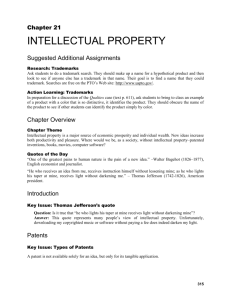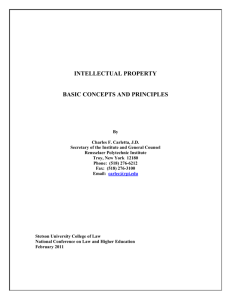T0006_Takamul Defining Intellectual Property Rights_18072013
advertisement
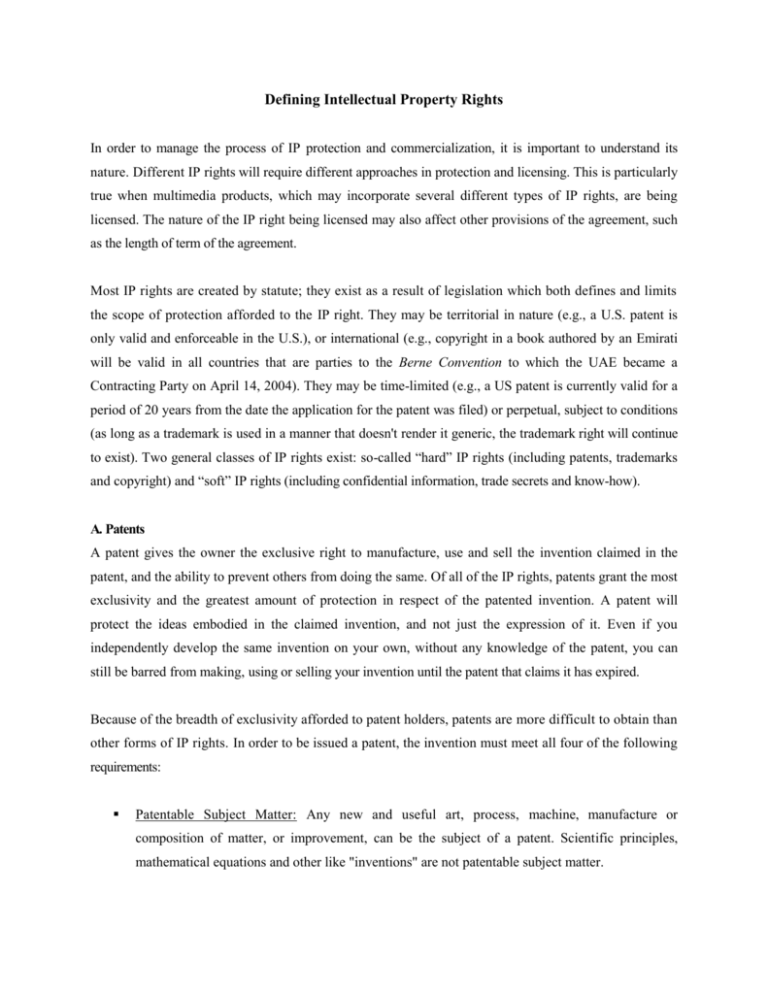
Defining Intellectual Property Rights In order to manage the process of IP protection and commercialization, it is important to understand its nature. Different IP rights will require different approaches in protection and licensing. This is particularly true when multimedia products, which may incorporate several different types of IP rights, are being licensed. The nature of the IP right being licensed may also affect other provisions of the agreement, such as the length of term of the agreement. Most IP rights are created by statute; they exist as a result of legislation which both defines and limits the scope of protection afforded to the IP right. They may be territorial in nature (e.g., a U.S. patent is only valid and enforceable in the U.S.), or international (e.g., copyright in a book authored by an Emirati will be valid in all countries that are parties to the Berne Convention to which the UAE became a Contracting Party on April 14, 2004). They may be time-limited (e.g., a US patent is currently valid for a period of 20 years from the date the application for the patent was filed) or perpetual, subject to conditions (as long as a trademark is used in a manner that doesn't render it generic, the trademark right will continue to exist). Two general classes of IP rights exist: so-called “hard” IP rights (including patents, trademarks and copyright) and “soft” IP rights (including confidential information, trade secrets and know-how). A. Patents A patent gives the owner the exclusive right to manufacture, use and sell the invention claimed in the patent, and the ability to prevent others from doing the same. Of all of the IP rights, patents grant the most exclusivity and the greatest amount of protection in respect of the patented invention. A patent will protect the ideas embodied in the claimed invention, and not just the expression of it. Even if you independently develop the same invention on your own, without any knowledge of the patent, you can still be barred from making, using or selling your invention until the patent that claims it has expired. Because of the breadth of exclusivity afforded to patent holders, patents are more difficult to obtain than other forms of IP rights. In order to be issued a patent, the invention must meet all four of the following requirements: Patentable Subject Matter: Any new and useful art, process, machine, manufacture or composition of matter, or improvement, can be the subject of a patent. Scientific principles, mathematical equations and other like "inventions" are not patentable subject matter. Novelty: The invention must not have been disclosed in a manner such that that it had become available to the public prior to the filing date of the application (if the disclosure was by a third party), or prior to one year before the filing date of the application (if the disclosure was by the inventor). Non-Obviousness: The invention must reflect some amount of inventive ingenuity; in other words, it must not be obvious to a skilled professional in the art, having regard to all of the other information and prior art available to him or her. Utility: The invention must serve some functional purpose and it must deliver the results promised in the patent, if any. The term of a patent (i.e., the length of time during which the patentee is able to exercise its exclusive rights) is currently twenty years from the application date in most jurisdictions. A patent is acquired by filing an application which discloses the invention sufficiently and sets out in the claims the precise invention that will be protected. Because patents eventually become public documents, some corporations may choose not to disclose their inventions and maintain the invention instead as a trade secret (see Soft Rights below). B. Trademarks Trademark rights, if registered, give the owner the exclusive right to the use of the trademark in a country in respect of the wares and services associated with it, and the right to prevent others from using the same or confusingly similar marks. A trademark may be a word or combination of words, designs, symbols, colors, fragrances or the “get-up” of a package or product. Trademark rights do not necessarily have to be registered, as the right itself is acquired through use of the trademark that designates the source of origin of goods and/or services with which the trademark is associated. Owners of unregistered trademark rights can prevent a third party from using their trademarks, but only if they can establish that the third party is attempting to deceive the public by “passing-off” its goods and/or services as those of the trademark owner. Trademark registrations may be renewed indefinitely subject to the continued use of the mark. Failure to use the trademark may expose a trademark owner to an expungement proceeding, which, if successful, would result in the removal of the mark from the registry. It is also possible to lose a trademark right if the distinctiveness of the mark is lost and it becomes “generic”. Examples of trade- marks that have become generic in some jurisdictions include THERMOS, ASPIRIN and MARGARINE. It is incumbent on a trademark owner to police infringements of its trademark rights and enforce those rights to avoid losing distinctiveness of the mark. C. Copyright Copyright gives its owner the sole right to produce or reproduce the protected work. Copyright can subsist in any original literary, artistic, musical or dramatic work, or any substantial part thereof, in any material form whatever. The copyright arises automatically upon creation of the work - no registration is required, although registration does offer some limited presumptions of validity in the event of litigation. Copyright offers a far more limited scope of protection than a patent because it protects the expression of the original work, but not the underlying ideas. As long as there is no actual copying involved, anyone can produce a similar work even if they are using the same underlying ideas. Under copyright law, there are a number of related and more specific rights, including the right to: Perform the work in public; Publish the work, if it is unpublished; Produce, reproduce, perform or publish any translation of the work; Convert a dramatic work into a novel or other non-dramatic work; Convert any non-dramatic work into a dramatic work by way of performance in public or otherwise; Make a sound recording, cinematograph film or other contrivance by means of which a literary, dramatic or musical work can be mechanically reproduced or performed; reproduce, adapt or publicly present any work as a cinematographic film; Communicate a work to the public by way of telecommunication Publicly exhibit, for a purpose other than sale or hire, any artistic work created after June 7, 1988 other than maps, charts, or plans; Rent a copiable computer program or sound recording (for musical works); and Authorize any of the above acts. Any of the above rights may be licensed individually or as a bundle of rights granted to a licensee. Copyright law also recognizes moral rights accorded to original authors of protected works. Moral rights may not be assigned, and can only be waived. Moral rights enable authors to protect the integrity of the work. In North America, copyright generally subsists for the life of the author plus 50 years, but there are exceptions depending on the type of work and whether it was authored by one or more persons. D. “Soft” IP Rights “Soft” IP rights usually refer to a category of rights that are not protected by legislation (as is the case for patents, trademarks, copyrights and others) but nonetheless fall into the category of “intangible” rights and are usually associated with other IP rights. These rights include know-how, trade secrets and confidential information. The terms “confidential information”, “proprietary information” and “trade secrets” are often used interchangeably; however, the courts' interpretation of those terms have had noted distinctions. A trade secret is considered to be information that is actually secret in an objective sense. For example, the recipe for Coca Cola and the recipe for Kentucky Fried Chicken are actual trade secrets, unknown to anyone other than the companies that own the products and their employees. Confidential or proprietary information, on the other hand, may not necessarily be known only to the owner of it - it may be a compilation of information that has been collected by a company through the expenditure of time and resources, and therefore it has value without being inherently “secret”. Because it has value, the circulation of that information would deprive the owner of it with the benefit of having collected it. Examples of confidential information include customer lists, databases and certain know-how. While courts may acknowledge the existence and value of confidential information and trade secrets, confidential information is not usually considered to be property in the same way as other IP rights. The only practical way to preserve the value of that information is through the enforcement of contractual obligations or obligations of good faith arising from a relationship. The benefit of maintaining a trade secret is that it does not expire; the right preserves its value for so long as the information remains confidential, and therefore the period of exclusivity may be indefinite. However, once the information becomes public, the trade secret loses all of its value. Even though the trade secret owner may have a right of recourse against a third party who, though wrongful actions, disclosed the trade secret, that may not compensate for the loss in value, and innocent parties who receive the information may be free to exploit it without sanction. It is, therefore, the most tenuous of IP rights. Know-how may be a subset of trade secrets or confidential information. It is often licensed concurrently with patent rights - the patent disclosure, while sufficient to describe the invention claimed, may not include other technical information that may be valuable to a licensee in exploiting the invention, such as information relating to the optimum commercial exploitation of a technology.




